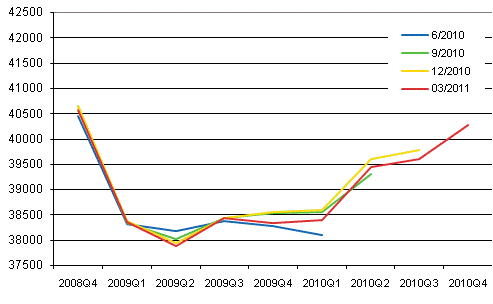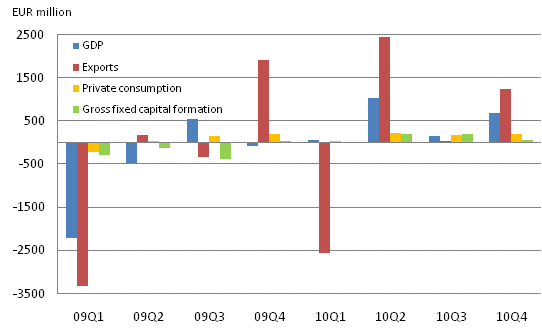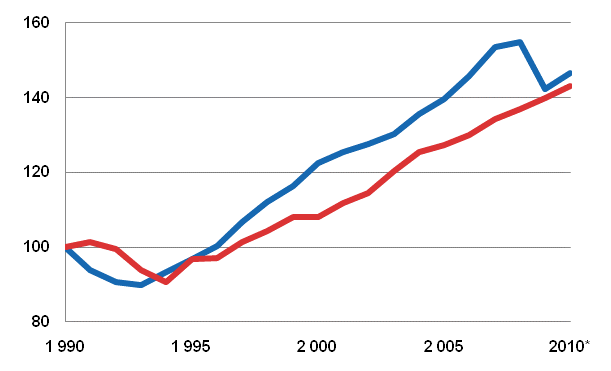1. Gross domestic product grew by 3.1 per cent in 2010
The volume of GDP grew by 3.1 per cent last year. Over the October to December period, GDP grew by 1.7 per cent from the previous quarter. Compared with the last quarter of 2009, GDP increased by 5.2 per cent. Revisions put the change in the volume of GDP in the third quarter of 2010 at +0.4 per cent from the previous quarter (was +0.5 %) and at +3 per cent from twelve months back (was +3.7 %).
Output grew strongest in the second and fourth quarters of the year. On account of the strong growth in the last quarter, the seasonally adjusted volume of GDP exceeded the level of 2006, but was still at a lower level than in 2007 and 2008.
Figure 1. Revisions - seasonally adjusted volume of GDP by release

According to the preliminary data compiled by Eurostat, in the fourth quarter of 2010 GDP increased in the EU area by 0.2 per cent from the previous quarter and by 2.1 per cent from twelve months back.
1.1. Output
From October to December, the volume of value added in primary production increased by 6.4 per cent from the previous quarter. Primary production grew by 5.9 per cent over the whole of 2010. Value added in agriculture contracted by 2.2 per cent. In the forest industry value added went up by 10.7 per cent last year.
The volume of value added in secondary production, that is, manufacturing and construction, went up by 4.8 per cent from the previous quarter. Value added in manufacturing grew by 5.9 per cent from the previous quarter. Output in the metal industry (incl. electronics industry) grew most: by 9.7 per cent. Value added in the wood and paper industry increased by 1.9 per cent and that in other manufacturing industry by two per cent. From October to December, the volume of value added in construction increased by 3.4 per cent from the previous quarter.
The volume of secondary production grew by 5.9 per cent in the whole of 2010. Value added in manufacturing went up by 6.3 per cent. In the metal industry output grew by 5.3 per cent. The growth recorded in the wood and paper industry amounted to 9.8 per cent. In other manufacturing output grew by 3.9 per cent. Value added in manufacturing rose by five per cent from the previous year.
From October to December, the volume of value added in service industries increased by 0.8 per cent from the previous quarter. Trade went up by 3.1 per cent. Transport, storage and communications increased by 0.7 per cent. Real estate and business activities grew by 0.9 per cent.
In the whole of 2010 the volume of value added in service industries went up by 1.8 per cent. Value added in trade grew by 5.9 per cent; sale of motor vehicles increased most, retail trade least. Transport, storage and communications increased by 5.5 per cent. Real estate and business activities grew by 0.6 per cent. Value added in financial intermediation and insurance included in other industries contracted slightly last year.
1.2. Imports, exports, consumption and investments
All the demand components of the national economy increased in the last quarter compared with the previous quarter. The volume of total demand grew by 3.1 per cent in 2010.
Figure 2. GDP and expenditure components, change from previous quarter (seasonally adjusted, at reference year 2000 prices)

From October to December, the volume of exports increased by 6.6 per cent from the previous quarter. Exports of goods grew by three per cent and exports of services by 17.6 per cent from the previous quarter. The volume of exports increased by 5.1 per cent over 2010. Exports of goods grew by 10 per cent, but exports of services fell by 6.7 per cent.
From October to December, the volume of imports contracted by 4.6 per cent from the previous quarter. Imports of goods fell by 1.7 per cent and those of services by 10.8 per cent from the previous quarter. The volume of imports grew by 2.6 per cent over 2010. Imports of goods grew by 9.8 per cent, but imports of services contracted by 13.7 per cent.
In the last quarter the volume of private consumption went up by one per cent from the previous quarter. The volume of public consumption expenditure increased by 0.5 per cent from the previous quarter.
In the whole of 2010 private consumption grew by 2.6 per cent. Over the year the volume of consumption of durable goods increased by 12.5 per cent, that of semi-durable goods by 2.4 per cent, that of non-durable goods by 2.6 per cent and that of services by 1.7 per cent. The volume of government consumption expenditure grew by 0.4 per cent.
In the last quarter the volume of investments went up by 0.7 per cent from the previous quarter. Construction investments increased by 3.5 per cent. Investments in residential buildings grew by 4.1 per cent and investments in non-residential buildings by 2.4 per cent. Only investment in civil engineering fell by 0.3 per cent. The volume of investments in machinery, equipment and transport equipment grew by 2.3 per cent.
Over the year 2010 investments increased by 0.8 per cent. Investments in residential buildings grew by 22.2 per cent but those in non-residential buildings diminished by 12.5 per cent. The volume of civil engineering investments contracted by 8.8 per cent. Investments in machinery, equipment and transport equipment fell by five per cent. Other investments, mainly consisting of software investments, contracted by 4.5 per cent.
1.3. Employment
No essential changes took place in the employment situation in the last quarter. The number of hours worked in the national economy grew by one per cent from the previous quarter. In the whole of 2010 the number of employed persons fell by 0.4 per cent and the number of hours worked grew by 1.1 per cent.
According to Statistics Finland’s Labour Force Survey, the rate of unemployment in the October to December period was 7.4 per cent. In the corresponding period of 2009 it stood at 8.2 per cent. The unemployment rate for 2010 was 8.4 per cent.
1.4. Prices
The economy’s overall price level is estimated to have risen by 2.1 per cent last year as measured by the GDP price index.
The change in the Consumer Price Index was 1.2 per cent last year, but the price index of household consumption expenditure in National Accounts grew by 0.9 per cent. In National Accounts, the prices of housing services are measured with changes in market rents only, whereas the Consumer Price Index also takes into consideration expenditure of owner-occupied housing. The methods used in National Accounts and in the Consumer Price Index for measuring development in the prices of insurance and financial intermediation services also deviate from each other.
The terms of trade weakened, because import prices rose by 5.6 per cent and export prices by 4.1 per cent.
1.5. National income grew by 2.3 per cent in real terms
Net national income grew by 5.8 per cent in nominal terms and by 2.3 per cent real terms last year, and was EUR 28,700 per capita. Finland’s gross national income was EUR 183 billion last year, or EUR 2.5 billion more than GDP.
Households’ wage and salary income went up by 1.9 per cent and employers’ social insurance contributions by 1.3 per cent. Compensation of employees increased by a total of 1.8 per cent and their share of the national income contracted to 59.6 per cent. In the previous year, the share was 61.9 per cent. Property and entrepreneurial income increased by 17 per cent and their share of the national income stood at 26.5 per cent. The respective share in the previous year was 23.9 per cent.
1.6. Non-financial corporations’ profits went up again
Non-financial corporations' operating surplus describing profits from their actual operations went up by 36 per cent in nominal terms from the previous year. Their entrepreneurial income grew by 30 per cent but was still clearly lower than in the peak year of 2007. Entrepreneurial income also takes into consideration property income and paid interests and corresponds roughly with profit before payment of taxes and dividends.
Last year, non-financial corporations paid 37 per cent more direct taxes but four per cent less dividends than in the year before.
Non-financial corporations’ fixed investments in Finland diminished by five per cent in nominal terms last year. Their net lending, or financial position, showed a surplus of EUR 9 billion.
Financial corporations’ commission income went up but interest income (financial intermediation services indirectly measured) fell. The credit and deposit stock continued to grow but the average level of interest rates was lower than in the year before. The financial position of insurance and financial corporations showed a surplus of some EUR 0.5 billion.
1.7. General government deficit 2.5 per cent of gross domestic product
The financial position of central government showed a notable deficit for the second successive year last year. The deficit was nearly EUR 10 billion and was larger than in the previous year but slightly smaller than at the beginning of the 1990s.
State revenues from taxes went up by 2.4 per cent. Revenues from indirect taxes grew by 4.4 per cent due to, among other things, raising of the value added tax rate, but revenues from direct taxes decreased by 1.3 per cent. Corporation tax revenue received by central government went up, but income taxes paid by households to central government decreased due to lightened taxation.
Income transfers to local government (incl. repayments of value added tax) went up by 6.2 per cent and those to social security funds, especially to the the Social Insurance Institution of Finland, by 13 per cent. Final consumption expenditure of central government grew by 0.4 per cent in nominal terms whereas investments decreased by 1.8 per cent.
The deficit of municipalities and joint municipal boards was EUR 0.5 billion or so, or smaller than in the year before. Municipalities' tax income grew by 5.4 per cent. Final consumption expenditure went up by over three per cent in nominal terms and investments are estimated to have increased by four per cent.
The financial surplus of employment pension funds remained on level with the previous year at around EUR 5 billion. Revenue from pension contributions and property income grew by roughly the same amount as paid employment pensions. The finances of other social security funds were in balance.
The total financial position, or net lending, of general government showed a deficit of EUR 5 billion, or about the same amount as in the year before. The so-called EDP deficit defined in the European Union's Growth and Stability Pact deviates slightly from the general government net lending of National Accounts, and it stood at EUR 4.4 billion, or 2.5 per cent of GDP. The so-called EDP debt, or consolidated gross debt, of general government went up to over EUR 87 billion. Its share of GDP rose to 48.4 per cent, putting it on level with 1998. Statistics Finland will publish the deficit and debt data that must be reported to the EU Commission on 31 March 2011. The deficit and debt data published here may become revised in that connection.
The proportion of public expenditure of gross domestic product was 55.1 per cent. In the previous year, it was 56.3 per cent.
The tax rate, or the proportion of taxes and tax-like payments of GDP, contracted to 42.2 per cent last year. The tax rate has fallen by five percentage points from its peak level in the year 2000.
1.8. Households’ real income grew by nearly three per cent
Households’ disposable income grew by 3.8 per cent in nominal terms and by 2.9 per cent in real terms. Households’ adjusted disposable income increased by 3.6 per cent in nominal terms and by 2.3 per cent in real terms. Adjusted income also takes into consideration the personal services which organisations and general government produce for households, such as educational, health and social services.
Figure 3. The real gross dowesticproduct (upper lline) and households' adjusted disposable income (lower line) 1990=100

Households’ wage and salary income went up by two per cent and received social benefits by four per cent. Wage and salary income was put up by risen level of earnings. By contrast, direct taxes paid by households decreased by some 1.5 per cent.
Entrepreneurial income from agriculture and forestry went up by seven per cent. Imputed income from owner-occupied dwellings grew by 18 per cent due to fallen interest rates. Other entrepreneurial income went up by 13 per cent. Dividend income is estimated to have grown by three per cent.
Households’ final consumption expenditure increased by 3.7 per cent. Consumption expenditure was lower than disposable income, so the savings ratio, or savings relative to disposable income, was 4.5 per cent in the positive. Households’ fixed investments went up by six per cent due to increased housing construction. Households’ financial position showed a surplus of EUR 0.5 billion or so.
Households’ indebtedness rate went up again and was 113.4 per cent at the end of September. The indebtedness rate expresses the ratio between the credit stock and annual disposable income in accordance with financial accounts.
1.9. Next revisions in June and July 2011
Data concerning the first quarter of 2011 will be released on 3 June 2011. National Accounts for 2010 with more detailed data contents will be released on 14 July 2011 in accordance with the revised Standard Industrial Classification TOL2008. At the same time, the data for 2008 and 2009 will be revised.
These preliminary data are based on the information on economic development available by 22 February 2011. Methodological descriptions of National Accounts can be found on Statistics Finland’s website at: http://tilastokeskus.fi/til/vtp/men_en.html and http://tilastokeskus.fi/til/ntp/men_en.html
Source: National Accounts. Preliminary annual data and 4th quarter of 2010 Statistics Finland
Inquiries: Olli Savela (09) 1734 3316, Aila Heinonen (09) 1734 3338, skt.95@stat.fi
Director in charge: Ari Tyrkkö
Updated 1.3.2011
Official Statistics of Finland (OSF):
Annual national accounts [e-publication].
ISSN=1798-0623. 2010,
1. Gross domestic product grew by 3.1 per cent in 2010
. Helsinki: Statistics Finland [referred: 10.1.2026].
Access method: http://stat.fi/til/vtp/2010/vtp_2010_2011-03-01_kat_001_en.html

